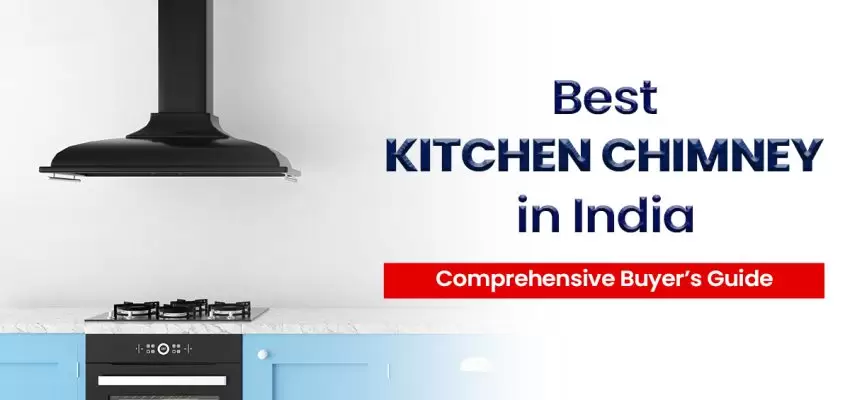When you cook delicious food in your kitchen, it can create a lot of smoke and smells that stick to your kitchen walls and ceiling. To solve this problem, you can use a kitchen chimney. A kitchen chimney is like a machine that sucks up the smoke and smells, so your kitchen stays clean and odor-free. Plus, it can make your modern kitchen look even nicer.
Post your Requirement
If you want to buy a kitchen chimney, whether online or in a store, there are a few important things to think about. Here through this blog, we offer a comprehensive kitchen chimney buying guide at your fingertips.
Why is a chimney necessary in the kitchen?
A chimney is necessary in the kitchen for these reasons:
- Smoke and Odor Removal: It helps to get rid of smoke and strong smells produced during cooking.
- Air Quality: Improves air quality by removing harmful fumes and pollutants.
- Kitchen Cleanliness: Prevents sticky residues from settling on walls and ceilings.
- Comfortable Cooking: Creates a comfortable and safe environment for cooking.
- Health Benefits: Reduces the risk of inhaling harmful cooking byproducts.
- Aesthetic Value: Adds a stylish and modern look to your kitchen.
- Overall Safety: Enhances safety by preventing the accumulation of cooking-related hazards.
Types of kitchen chimney
Below we have mentioned the various types of kitchen chimneys:
- Wall Mounted Chimney: This chimney is installed on the kitchen wall, right next to the stove and hob.
- Island Chimney: Designed for kitchens where the cooking area is at the center, away from the wall, with concealed ducts in a false ceiling.
- Built-in Chimney: Integrated into kitchen cabinets, this chimney is flush against the wall.
- Corner Chimney: Positioned in the corner of the kitchen, typically when the stove is against one of the walls.
Types Of Chimney Filters
Here is the list of chimney filters available :
- Baffle Filter: A baffle filter is durable, low maintenance, and less noisy than others. It efficiently traps oil and grease, making it suitable for Indian cooking.
- Cassette/Mesh Filter: Comprising multiple mesh layers, this filter captures oil, grease, and smoke particles but requires regular cleaning.
- Carbon Filter: Made of charcoal plates, carbon filters absorb smoke and oil particles effectively, although they are non-washable and must be replaced every few months.
- Filterless Chimney: Filterless chimneys, while a bit costlier, are low maintenance and highly effective in removing cooking byproducts.
Things to consider before buying a chimney
Here are some simple points to think about before getting a chimney for your kitchen:
- Suction Capacity: Suction power in a kitchen chimney is its ability to remove oil particles and odors, measured in cubic meters per hour (m3/hr). In Indian kitchens, it’s best to have a range of 400 to 1000 m3/hr, based on kitchen size and frequency of cooking. Longer hoses typically mean stronger suction.
- Kitchen Chimney Size: Choose a chimney size that matches your kitchen and stove or hob. It should be proportionate to your cooking area.
- Types Of Filters: A malfunctioning filter in a kitchen chimney can decrease suction and pose health risks. Selecting the correct filter is important for the chimney’s efficiency and a safe kitchen.
- Maintenance: Choose a kitchen chimney that’s simple to maintain, ensuring hassle-free cleaning and upkeep. Installing it at a lower height makes maintenance even more accessible.
- Noise Control: Opt for a kitchen chimney that operates quietly to reduce disruptions during cooking. Some models offer pre-silent kits for a peaceful cooking environment.
- Variable Speeds: Select a chimney with adjustable speed settings to match your ventilation needs. Advanced models provide multiple speed options for efficient kitchen air circulation.
- Glass Styles: Kitchen chimneys come in two designs – curved glass for a modern look and improved visibility, and straight glass for a minimalistic appearance with strong suction power, ideal for modern kitchens.
Best Kitchen Chimney Brands In India
Below we have mentioned the top brands selling Kitchen Chimney in India:
- BlowHot Kitchen Chimney
- Bosch Kitchen Chimney
- Carysil Kitchen Chimney
- Elica Kitchen Chimney
- Faber Kitchen Chimney
- Hettich Kitchen Chimney
- Hindware Appliances Kitchen Chimney
- Kaff Kitchen Chimney
- Mercy Kitchen Chimney
Kitchen Chimney Maintenance Tips
A clean kitchen chimney is essential to maintain a smoke, dirt, and odor-free kitchen environment. A blocked chimney not only hampers the appliance’s performance but also contributes to kitchen air pollution. Below we have some non-negotiable kitchen chimney maintenance tips:
- Regular Cleaning: Clean your kitchen chimney based on its usage, with heavy usage needing monthly cleaning. Use the right cleaning products to avoid damage.
- Filter Replacement: Replace filters regularly, typically every six months, to maintain efficient functioning.
- Ductwork Check: Ensure the ductwork is unobstructed and properly sealed to prevent leaks.
- Annual Inspection: Have a professional inspect your chimney and ductwork annually for any issues and necessary repairs.
Conclusion
A good chimney enhances your cooking area and home value, making your cooking experiences enjoyable and trouble-free for a long time. Choosing the right kitchen chimney is more than just how it looks. Hope our guide helped you make an informed decision. Consider your kitchen’s requirements, chimney types, suction power, noise, brand reputation, and energy efficiency.
FAQs
Q-1. Which type of kitchen chimney is best?
A-1. The best kitchen chimney type depends on your kitchen’s layout. Wall-mounted chimneys are common, but island or built-in options may suit specific setups.
Q-2. Is a chimney effective in an Indian kitchen?
A.-2. Yes, a chimney is highly effective in Indian kitchens, as it removes smoke, odors, and grease produced during cooking, enhancing air quality and cleanliness.
Q-3. When should we use a kitchen chimney?
A-3. You should use a kitchen chimney whenever you cook to maintain a clean, odor-free, and safe cooking environment by expelling cooking byproducts.























Post A Comment